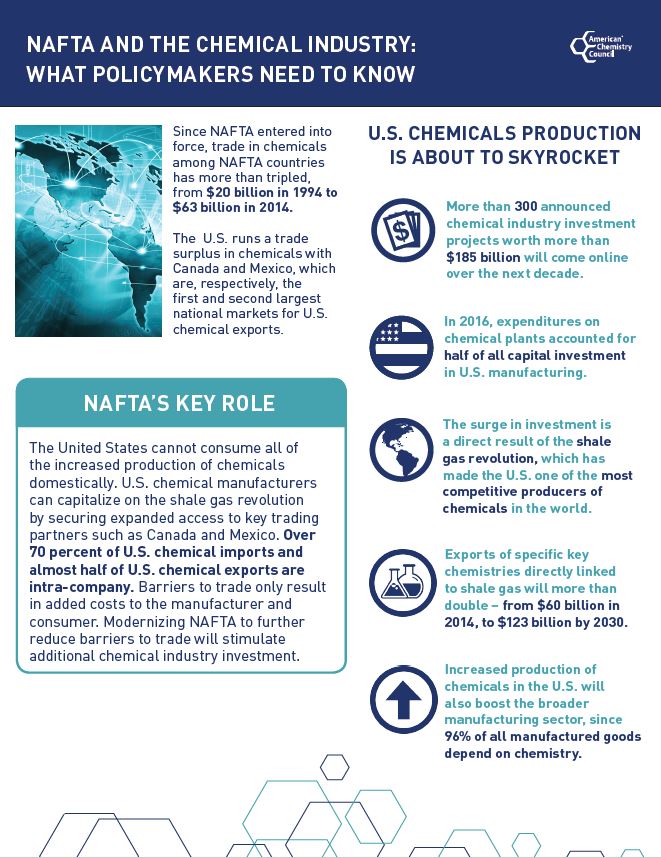Chemical manufacturing in North America is an illustration of the promise of free trade and regional economic integration. The North American Free Trade Agreement (NAFTA) has played an important role building a North American market for chemical manufacturers and their customers. Modernizing NAFTA presents an opportunity to take that promise even further.
The data tell an important story. Since 1994, when NAFTA first entered into force, trade in chemicals among NAFTA countries has more than tripled, from $20 billion in 1994 to $63 billion in 2014. In recent years, the U.S. has run a trade surplus in chemicals with Canada and Mexico, which are, respectively, the first and second largest national markets for U.S. chemical exports.
A modernized NAFTA presents an opportunity for North American chemical manufacturers to do even more to build upon the economic partnerships and supply chain synergies and efficiencies that have been created through reduced barriers to trade.
Five areas of opportunity within NAFTA
The American Chemistry Council (ACC), which represents U.S. chemical manufacturers, has identified five key areas in which NAFTA can help achieve that goal:
- Maintain duty-free trade for all qualifying chemical products. Given that more than 50 percent of trade in chemicals is intra-company, imposing trade barriers in chemicals within NAFTA would be like putting a tollbooth in the middle of a factory.
- Modernize the Rules of Origin. Rules of origin should be brought into line with rules adopted in more recent U.S. trade agreements, providing a clear, transparent, and flexible menu of options for determining origin.
- Modernize border measures and trade clearance disciplines. A modernized NAFTA should promote digital trade to reduce paperwork and protect data flows, remove bottlenecks, modernize transport and security requirements, and harmonize clearance procedures.
- Strengthen regulatory coherence. Negotiating parties should work together to strengthen the implementation of Good Regulatory Practices, including promoting greater transparency and inviting stakeholder dialogue on regulations.
- Promote greater alignment on chemical regulation. NAFTA countries should strengthen and align a risk- and science-based approach to chemical regulation throughout North America, which can serve as a model for the rest of the world.
A united stance on Regulatory Cooperation, Rules of Origin
As the negotiations to modernize NAFTA have begun to move forward, chemical industry associations in the United States, Canada, and Mexico have worked to develop joint recommendations to negotiators on several key discussion areas.
The initial two joint papers are on enhancing Regulatory Cooperation and upgrading the Rules of Origin. ACC, together with our North American partners, the Chemistry Industry Association of Canada (CIAC) and the Mexican Chemical Industry National Association (ANIQ), have developed these recommendations to illustrate the strong level of alignment within the North American chemical industry on priorities for NAFTA modernization.
Addressing regulatory cooperation opportunities holds great promise for better value creation and integration of the Canadian, Mexican, and American economies. Enhanced regulatory cooperation seeks to maintain high levels of protection for human health and the environment, while promoting greater alignment and burden-sharing between regulators. This has the potential to significantly reduce costs for governments and industry alike.
Examples of how a modernized NAFTA could further support regulatory cooperation include promoting alignment on classification and labeling requirements, and collaborating on risk-based assessments for priority chemicals.
On rules of origin under a modernized NAFTA, the three industry groups agree that the rules should be clear, simple, and transparent. The goal should be to reduce transactional time and costs to the maximum extent possible while ensuring that these benefits apply only to the NAFTA partners.
In a statement issued on September 11, CIAC President and CEO Bob Masterson said of industry’s united position:
“Implementation of these agreed positions will encourage regulatory harmonization capable of protecting people and the environment in all three countries while also spurring innovation and improving our overall regional position in the highly competitive global chemistry sector.
“A great amount of effort by our respective associations and the industry in all three countries has gone into landing on these consensus positions. We are leading the way in demonstrating that there are indeed opportunities to modernize NAFTA while delivering benefits to all three partners to the agreement,” Masterson concluded.
Download the industry recommendations on Regulatory Cooperation
Download the industry recommendations on Rules of Origin






